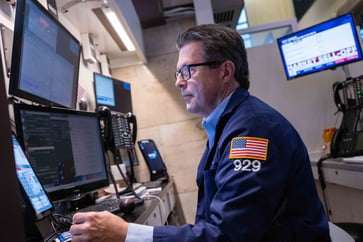According to Mizuho, the long-term winners in the U.S. power sector will be those that benefit from AI technology.

By 2030, the use of artificial intelligence is expected to drive a rapid increase in power demand from data centers, which will triple, according to Mizuho Securities. This will result in an explosion in renewable energy and natural gas.
By the end of the decade, the demand for data centers will account for approximately 9% of the total U.S. electricity demand, with an annual requirement of 50 gigawatts or 400 terawatt hours, according to a Mizuho report published on Friday.
The Mid-Atlantic region accounts for approximately 30% of current data center demand, while Texas follows with 13%.
The technology sector's climate commitments are expected to drive the growth of renewables, with solar demand increasing by 7 gigawatts annually and wind growing by 5 gigawatts per year through 2030. This represents an upside of 21% and 39% for solar and wind, respectively, over Mizuho's current forecast.
Solar tracker companies such as and are likely to benefit the most in the renewable space because they can easily ramp up production capacity via steel contract manufacturers in a capital light fashion, according to analyst Maheep Mandloi.
Mizuho's current price target of $59 per share could potentially generate a $4 upside for Nextracker if it holds 45% market share in the U.S., while Array could capture a $2 upside to Mizuho's price target of $13 per share.
The outcome of the November presidential election will determine whether solar module manufacturing stocks move much or not, according to Mandloi.
The IRA's continuation may increase competitive pressure for companies like First Solar, but the analyst predicts a potential $17 increase in the current price target of $274 per share for First Solar.
By 2030, natural gas demand is predicted to increase by up to 4 billion cubic feet per day, which is equivalent to 4% of current U.S. production, according to Mizuho. If the growth of renewables does not occur as quickly as anticipated, gas demand could increase by up to 8 billion cubic feet per day by the end of the decade.
The report states that gas will mainly serve as a backup power source, supplementing solar and wind energy when weather conditions affect their availability, and enhancing energy supplies in regions where data centers are not situated near renewable power plants.
The primary beneficiaries of the key data center markets in the Mid-Atlantic and Southeast are likely to be gas producers such as, while pipeline operators like and also benefit from their incumbency advantage due to the uncertainty over new interstate pipelines being built in the U.S., according to Mizuho analysts Nitin Kumar and Gabriel Moreen.
Analyst Anthony Crowdell stated that independent power producers are well positioned if they can sign agreements to power data centers using their nuclear fleet.
While there is a strong desire for AI technology, Mizuho analysts warned that the industry faces several obstacles, including the lengthy process of obtaining permits and connecting new power projects to the grid, which can take up to five years.
If a new administration cancels incentives under the Inflation Reduction Act (IRA) or imposes higher import tariffs, renewable investments could be delayed, according to analysts.
PRO Home
You might also like
- Despite a 30% increase in Cathie Wood's ARKK fund following President Trump's re-election, outflows continue, and the fund is projected to reach $3 billion by 2024.
- What are the significant stock stories expected to influence the market on Tuesday?
- Goldman suggests these energy stocks to capitalize on the decline in crude oil.
- According to Mizuho, the long-term winners in the U.S. power sector will be those that benefit from AI technology.
- The market's next trading session will be influenced by Wednesday's significant stock stories.



